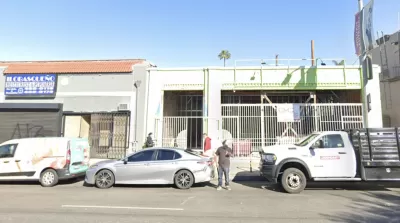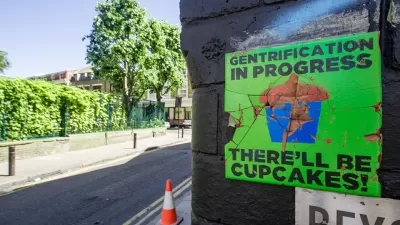New art galleries are moving into a neighborhood recently dubbed ‘Melrose Hill,’ prompting both derision and concern on the part of local residents.

Writing in Hyperallergic, Matt Stromberg calls out the new art galleries popping up in a Los Angeles neighborhood being billed as ‘Melrose Hill’ for claiming to ‘revitalize’ an area that never lost its vitality to begin with. “In fact, ‘desolate’ was precisely the word used to describe the area in a Vanity Fair article last month on the recent influx of galleries to the block, which drew immediate and sharp criticism from Angelenos who know better.”
As Stromberg explains, “The phenomenon of a neighborhood being re-branded by developers, often aided by Google Maps, to present an area as a kind of ahistorical blank slate is nothing new.” Stromberg adds, “There is, in fact, a neighborhood called Melrose Hill, just not where these new art spaces are located.” The real Melrose Hill includes a Historic Preservation Overlay Zone (HPOZ) that protects 45 historic California bungalows.
As for the ‘desolate’ neighborhood in question, “Residents are overwhelmingly renters, with low to average median incomes for the city. Once you move off the main commercial and transit arteries of Western and Melrose, the streets are filled with low apartment buildings, single-family homes, and courtyard housing, originally built by Hollywood studios to house their workers.”
Longtime community members express concern that the galleries have not conducted public outreach or attempted to integrate themselves into the existing community while bringing hundreds of cars crawling the neighborhood for parking to gallery events. The pattern is familiar for L.A. neighborhoods, which regularly undergo ‘rediscovery’ and gentrification. “Large sections of LA have been transformed by development and gentrification over the past 20 years, but the speed at which it is taking place here seems exceptional.”
FULL STORY: Art Galleries Are Not Reviving a “Desolate” LA Neighborhood

Planetizen Federal Action Tracker
A weekly monitor of how Trump’s orders and actions are impacting planners and planning in America.

Maui's Vacation Rental Debate Turns Ugly
Verbal attacks, misinformation campaigns and fistfights plague a high-stakes debate to convert thousands of vacation rentals into long-term housing.

Restaurant Patios Were a Pandemic Win — Why Were They so Hard to Keep?
Social distancing requirements and changes in travel patterns prompted cities to pilot new uses for street and sidewalk space. Then it got complicated.

In California Battle of Housing vs. Environment, Housing Just Won
A new state law significantly limits the power of CEQA, an environmental review law that served as a powerful tool for blocking new development.

Boulder Eliminates Parking Minimums Citywide
Officials estimate the cost of building a single underground parking space at up to $100,000.

Orange County, Florida Adopts Largest US “Sprawl Repair” Code
The ‘Orange Code’ seeks to rectify decades of sprawl-inducing, car-oriented development.
Urban Design for Planners 1: Software Tools
This six-course series explores essential urban design concepts using open source software and equips planners with the tools they need to participate fully in the urban design process.
Planning for Universal Design
Learn the tools for implementing Universal Design in planning regulations.
Heyer Gruel & Associates PA
JM Goldson LLC
Custer County Colorado
City of Camden Redevelopment Agency
City of Astoria
Transportation Research & Education Center (TREC) at Portland State University
Jefferson Parish Government
Camden Redevelopment Agency
City of Claremont





























